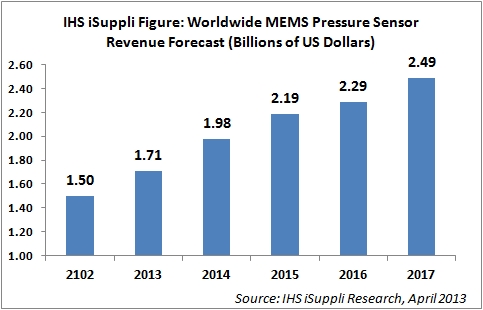Pressure sensors for automotive & wireless boost MEMS market

Microelectromechanical system (MEMS) pressure sensors will achieve accelerated growth this year and become the leading type of MEMS device, driven by increasing use in automotive and the fast-growing handset space.
This is according to insights from the IHS iSuppli MEMS & Sensors Service from information and analytics provider IHS.
Revenue for MEMS pressure sensors this year are projected to hit $1.71 billion, up 14 percent from $1.50 billion in 2012. This year's growth improves on the already solid 11 percent increase of 2012, but even rosier prospects are in store next year when expansion peaks at 16 percent. Steady, uninterrupted growth will continue until at least 2017, by which time the market will be worth $2.49 billion, as shown in the figure at the top of this story.
Used for control and monitoring purposes in myriad applications, pressure sensors are set this year to become the biggest-selling MEMS device, displacing the incumbent leaders: accelerometers and gyroscopes.
"Pressure sensors play a key role in automotive safety," says Richard Dixon, principal analyst for MEMS & sensors at IHS. "Because of this, the biggest market remains the automotive segment, where the sensors predominate in tire-pressure monitoring and braking systems. However, wireless applications - led by mobile handsets - will see the most explosive growth this year, up by 90 percent. Other important markets for pressure sensors are in medical electronics, industry, white goods and military/aerospace."
Automotive market rules the road
In the automotive sector, MEMS pressure sensor revenue in 2013 is expected to amount to $1.26 billion, or fully 74 percent of total industry revenue for the year. At least 18 automotive applications will fuel the space, including tire pressure, brake sensors used in electronic stability control systems, side airbags, engine control related to increasingly stringent emissions regulations worldwide, barometric pressure and exhaust gas recirculation pressure.
A rapidly growing new application is in gasoline direct-injection systems using high-pressure sensors up to 200 bar. Gasoline engines, especially in Europe where diesels make up a large proportion of vehicle sales, are enjoying a renaissance in light of upcoming emissions legislation in the EU, due in 2015. Diesel engines already employ many pressure sensors in the engine and in after-treatment systems.
Though automotive will lose some steam in the years to come, the segment will continue to command the largest revenue compared to other markets, with up to two-thirds of total industry takings even by 2017.
Wireless grabs spotlight and other areas also prosper
A strong new contributor this year is the wireless segment, particularly handsets. Pressure sensors will support indoor navigation, measuring altitude and providing a fast lock on global positioning systems that identify with precision on which floor of a building a user is located. Samsung first started using pressure sensors in its Galaxy S III smartphone in 2012, and Apple will be following suit soon, IHS believes.
Subsequent growth here will be very fast as other manufacturers jump on the bandwagon to offer the same functionality in their phones, making wireless the second-largest market after automotive already by 2014. This growth will continue and in 2017, every other smart phone should feature a pressure sensor.
Military/aerospace is a big mover; other markets also expand
For the remaining four markets, revenue growth this year for MEMS pressure sensors will range from 4 to 11 percent.
In medical electronics, pressure sensors will find their most extensive use in the form of blood pressure devices utilised during medical operations. The medical electronics market this year will be the second-biggest after automotive, with revenue of $143.9 million.
MEMS pressure sensors will also find prominent use in industrial electronics, a market worth $112.6 million in 2013; and in consumer electronics, valued at $45.2 million in 2013.
The industrial segment is highly fragmented with many applications, such as in boilers, pumps, and food or semiconductor processing. In comparison, consumer electronics is a small market at present for the sensors, consisting mainly of dive and sport watches, pedometers and hiking altimeters, as well as appliances like washing machines.
Dedicated personal heath-monitoring devices and activity monitors with a watch form factor, for instance, will potentially drive an additional wave of positive movement for pressure sensors, IHS expects.
Other examples that will do the same are motion-tracking devices that measure height for accuracy in stair counting.
Another notable segment is military/aerospace, driven by the commercial aircraft boom at U.S. maker Boeing and at pan-European entity Airbus. Although the total number of aircraft, jets, turboprops and helicopters sold worldwide is less than 10,000 per year, the number of pressure sensors being used here can be significant. A large jet, for instance, needs as many as 130 pressure sensors for an array of applications.
Prices are also high, running from the hundred-dollar to the thousand-dollar range, due to exacting performance requirements. Although the military/aerospace market is currently the smallest this year for MEMS pressure sensors at $39.8 million, growth will be solid at 11 percent.

































